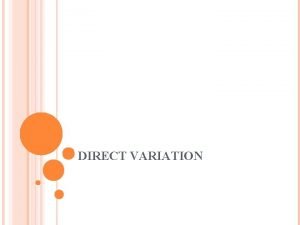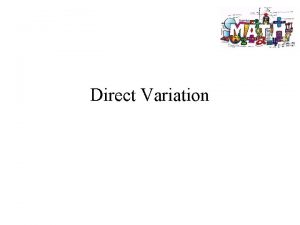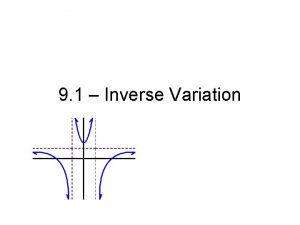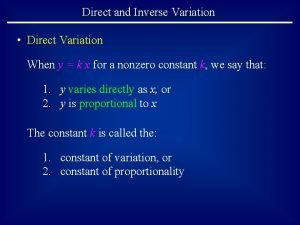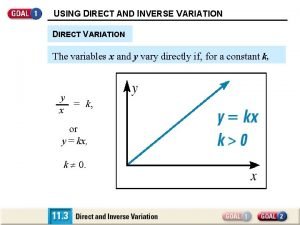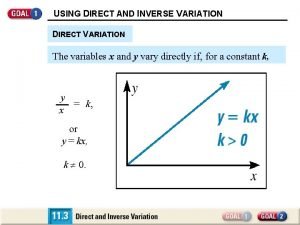Chapter 3 6 Variation Direct Variation When one













- Slides: 13

Chapter 3. 6 Variation

Direct Variation When one quantity is a constant multiple of another quantity, the two quantities are said to vary directly. For example, if you work for an hourly wage of $6, then [pay] = 6[hours worked]. Doubling the hours worked doubles the pay. Tripling the hours worked triples the pay, and so on.


The area of a rectangle varies directly as its length. If the are of 50 m 2 when the length is 10 m, find the area when the length is 25 m.


For example, the are of a square of side x is given by the formula so the area varies directly as the square of the length of a side. Here k = 1.

Inverse Variation The case where y increases as x decreases is an example of inverse variation. In this case, the product of the variables is constant, and this relationship can be expressed as a rational function.


In a certain manufacturing process, the cost of producing a single item varies inversely as the square of the number of items produced. If 100 items are produced, each costs $2. Find the cost per item if 400 items are produced.

Combined and Joint Variation One variable may depend on more than one other variable. Such variation is called combined variation. More specifically, when a variable depends on the product of two or more other variable, it is referred to as joint variation.


The are of a triangle varies jointly as the lengths of the base and the height. A triangle with base 10 ft and a height 4 ft has area 20 ft 2. Find the area of a triangle with base 3 ft and height 8 ft.

The number of variations per second (the pitch) of a steel guitar string varies directly as the square root of the tension and inversely as the length of the string. IF the number of vibrations per second is 5 when the tension is 225 kg and the length is. 60 m, find the number of vibrations per second when the tension is 196 kg and the length is. 65 m.
 What is a direct variation
What is a direct variation Examples of direct variation graphs
Examples of direct variation graphs Coefficient of determination formula in regression
Coefficient of determination formula in regression One god one empire one emperor
One god one empire one emperor One one one little puppy run
One one one little puppy run One king one law one faith
One king one law one faith Byzantine definition
Byzantine definition One ford
One ford See one do one teach one
See one do one teach one One price policy
One price policy Night structure
Night structure Studiendekanat uni bonn
Studiendekanat uni bonn One vision one identity one community
One vision one identity one community Graphic organizer with the aims of la liga filipina
Graphic organizer with the aims of la liga filipina














